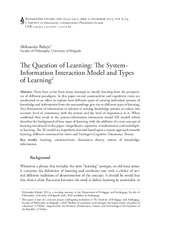Приказ основних података о документу
Tipovi učenja - model interakcije sistema i informacija
The question of learning: The system-information interaction model and types of learning
| dc.creator | Bulajić, Aleksandar | |
| dc.date.accessioned | 2021-10-12T11:45:54Z | |
| dc.date.available | 2021-10-12T11:45:54Z | |
| dc.date.issued | 2013 | |
| dc.identifier.issn | 0354-5415 | |
| dc.identifier.uri | http://reff.f.bg.ac.rs/handle/123456789/1638 | |
| dc.description.abstract | U naukama koje se bave učenjem i obrazovanjem, u prošlosti je, kao i danas, bilo više pokušaja da se klasifikuje učenje iz ugla različitih perspektiva i paradigmi. Ovaj rad predstavlja pokušaj da se nekoliko različitih kognitivističkih i konstruktivističkih refleksija o učenju sintetizuje u naporu da se objasni kako različiti tipovi interakcije nekog postojećeg individualnog sistema znanja i informacije iz sredine kreiraju i vode do različitih tipova učenja. Pri tome su u razmatranje uzete dve dimenzije informacije koje proističu iz njene interakcije sa sistemom znanja: nivo konzistentnosti informacije sa sistemom i nivo značaja koji informacija ima za sistem. Kombinovanje datih dimenzija informacije u svom odnosu prema postojećem sistemu znanja rezultiralo je kreiranjem modela interakcije sistema i informacije (SII model), koji opisuje poreklo razvoja četiri tipa učenja (kao rezultat modela nastala je i nova tipologija učenja): beznačajno, ekspanzivno, transformativno i maladaptivno učenje. Hipotetički model, predložen u radu, zasniva se na sistemskom pristupu učenju, različitim konstruktivističkim pristupima razmatranju učenja i Festindžerovoj teoriji kognitivne disonance. | sr |
| dc.description.abstract | There have so far been many attempts to classify learning from the perspectives of different paradigms. In this paper several constructivist and cognitivist views are synthesized in an effort to explain how different types of existing individual systems of knowledge and information from the surroundings give rise to different types of learning. Two dimensions of information in relation to existing knowledge systems are taken into account: level of consistency with the system and the level of importance to it. When combined they result in the system-information interaction model (SII model) which describes the background of four types of learning, with the addition of a new concept of learning introduced in the paper: insignificant, expansive, transformative and maladaptive learning. The SII model is a hypothetical model based upon a system approach towards learning, different constructivist views and Festinger's Cognitive Dissonance Theory. | en |
| dc.publisher | Univerzitet u Beogradu - Filozofski fakultet - Institut za pedagogiju i andragogiju, Beograd | |
| dc.relation | info:eu-repo/grantAgreement/MESTD/Basic Research (BR or ON)/179060/RS// | |
| dc.rights | openAccess | |
| dc.source | Andragoške studije | |
| dc.subject | učenje | sr |
| dc.subject | teorija kognitivne disonance | sr |
| dc.subject | sistem znanja | sr |
| dc.subject | konstruktivizam | sr |
| dc.subject | informacija | sr |
| dc.subject | system of knowledge | en |
| dc.subject | learning | en |
| dc.subject | information | en |
| dc.subject | dissonance theory | en |
| dc.subject | constructivism | en |
| dc.title | Tipovi učenja - model interakcije sistema i informacija | sr |
| dc.title | The question of learning: The system-information interaction model and types of learning | en |
| dc.type | article | |
| dc.rights.license | ARR | |
| dc.citation.epage | 23 | |
| dc.citation.issue | 2 | |
| dc.citation.other | (2): 9-23 | |
| dc.citation.rank | M24 | |
| dc.citation.spage | 9 | |
| dc.identifier.fulltext | http://reff.f.bg.ac.rs/bitstream/id/536/1635.pdf | |
| dc.identifier.rcub | https://hdl.handle.net/21.15107/rcub_reff_1638 | |
| dc.type.version | publishedVersion |

